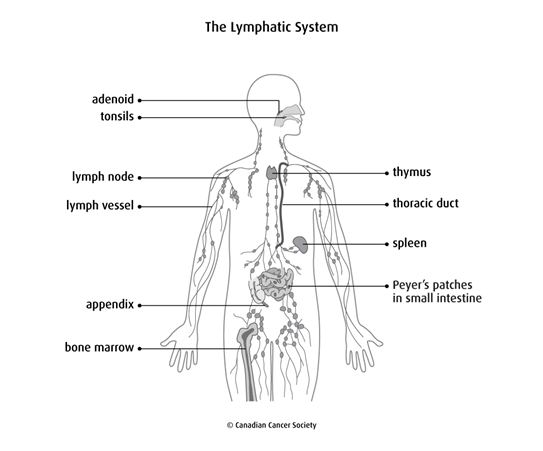What is childhood non-Hodgkin lymphoma?
Childhood non-Hodgkin lymphoma (NHL) is a cancer that starts in lymphocytes. Lymphocytes are cells of the lymphatic system.
The lymphatic system is an important part of the immune system that helps the body fight infection and disease. The lymphatic system is made up of lymph vessels, lymph nodes and lymphatic organs throughout the body. Childhood NHL can start anywhere in the lymphatic system.

Childhood NHL is classified according to the type of lymphocyte that it starts in. The 2 types of lymphocytes are B cells and T cells. Childhood NHL can start from B cells or T cells. Childhood NHL can also be classified by how the lymphoma cells look under a microscope.
Childhood NHL can be divided into the following types:
- Burkitt lymphoma (classical and atypical Burkitt lymphoma)
- lymphoblastic lymphoma
- diffuse large B-cell lymphoma (DLBCL)
- anaplastic large cell lymphoma (ALCL)
- primary mediastinal B-cell lymphoma
Burkitt lymphoma
Burkitt lymphoma (classical Burkitt lymphoma) and Burkitt-like lymphoma (atypical Burkitt lymphoma) are the most common types of childhood NHL. They usually occur in children 5 to 15 years old, and they are more common in boys.
Burkitt lymphoma is a type of B-cell lymphoma. It most often starts in the abdomen, but it can also start near the spine or in the neck, tonsils, sinuses, jaw, bone marrow or other parts of the body.
Burkitt-like lymphoma cells look slightly different from Burkitt lymphoma cells under a microscope. But they behave like Burkitt lymphoma cells, so the cancer is treated like Burkitt lymphoma.
Find out more about treatments for childhood Burkitt lymphoma.
Lymphoblastic lymphoma
Lymphoblastic lymphoma is most common in teenagers, and it occurs in boys more often than in girls.
Most lymphoblastic lymphoma starts from T cells, which are a type of lymphocyte. Lymphoblastic lymphoma often starts in the thymus, forming a mass in the area behind the sternum (breastbone) and in front of the trachea (windpipe). This can cause problems with breathing. It can also occur in the tonsils, neck, bone marrow or other parts of the body.
Some lymphoblastic lymphoma starts from B cells. It often starts in the head, neck, skin or bones.
Find out more about treatments for childhood lymphoblastic lymphoma.
Diffuse large B-cell lymphoma
Diffuse large B-cell lymphoma (DLBCL) is most common in people 10 to 20 years of age.
DLBCL starts from B lymphocytes. It can start in the lymph nodes, bone, neck or abdomen. It is the most common type of NHL in children who have a pre-existing weakened immune system (called immunodeficiency). Children without immunodeficiency can also develop DLBCL.
Find out more about treatments for childhood diffuse large B-cell lymphoma.
Anaplastic large cell lymphoma
Anaplastic large cell lymphoma (ALCL) is more common in younger children.
Most anaplastic large cell lymphoma starts in T lymphocytes, although sometimes it arises from other cells. The 2 main forms of ALCL are systemic (widespread in the body) or primary cutaneous (skin only). Systemic ALCL can start in lymph nodes in the neck or other parts of the body. It may also start outside the lymph nodes in the skin, lungs, bone, digestive system or other organs. When it starts outside the lymph nodes, it is described as extranodal.
Systemic ALCL has often spread to other parts of the body at diagnosis. Children with systemic ALCL often have fevers, night sweats and weight loss. When these occur together, they are called B symptoms.
Find out more about treatments for childhood anaplastic large cell lymphoma.
Primary mediastinal B-cell lymphoma
Primary mediastinal B-cell lymphoma starts from B lymphocytes. It usually occurs
as a large mass in the
Find out more about treatments for childhood primary mediastinal B-cell lymphoma.
Rare types of childhood NHL
Rare types of childhood NHL include:
- post-transplant lymphoproliferative disease (PTLD)
- follicular NHL
- marginal zone lymphoma, which can appear as nodal or extranodal mucosa-associated lymphatic tissue (MALT) lymphoma
- primary central nervous system (CNS) lymphoma
- peripheral T-cell lymphoma
- cutaneous T-cell lymphoma
The other main form of cancer of the lymphatic system that is seen in children and teens is Hodgkin lymphoma( HL). The abnormal B lymphocytes of Hodgkin lymphoma look and behave differently from non-Hodgkin lymphoma cells. Hodgkin lymphoma and non-Hodgkin lymphoma are treated differently.
The lymphatic system
Your trusted source for accurate cancer information
With support from readers like you, we can continue to provide the highest quality cancer information for over 100 types of cancer.
We’re here to ensure easy access to accurate cancer information for you and the millions of people who visit this website every year. But we can’t do it alone.
Every donation helps fund reliable cancer information, compassionate support services and the most promising research. Please give today because every contribution counts. Thank you.
